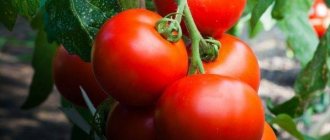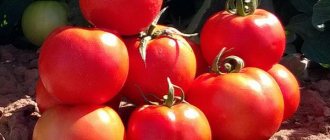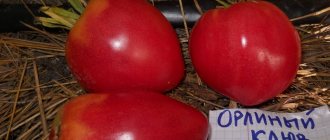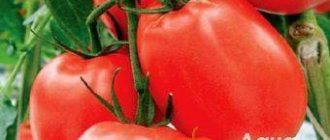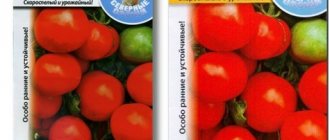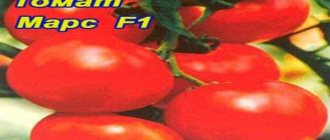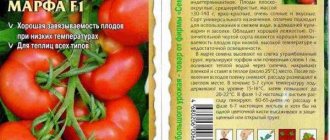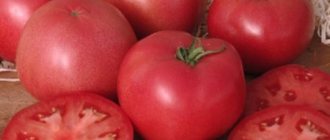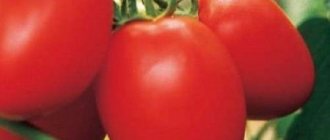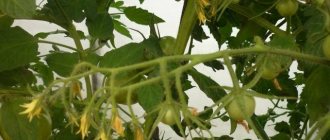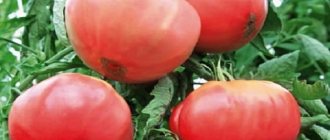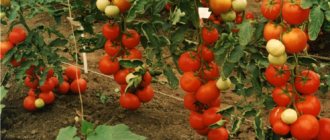Description of the tomato variety Torquay
The first generation hybrid Torquay F1 is a determinate tomato with a powerful root system and intense foliage. The growth type is standard, the formation of lateral shoots is minimal, the plant practically does not require pinching.
The tomato is a mid-early, heat-loving tomato; when the temperature drops to +100 C, the growing season stops.
Torquay F1 is demanding on lighting
Special lamps are installed in greenhouses to extend daylight hours to 16 hours. The harvest is harvested in two stages, the first tomatoes ripen in June, the next wave occurs in July-August. From the moment of germination to the ripening of the last harvest, 120 days pass, the first is harvested after 75.
All tomatoes have an even mass, the density of the brushes is the same from the first circle to the last.
The tomato bush Torquay F1 (pictured) has the following characteristics:
- Height – 80-100 cm, which is considered tall for a determinate species. The bush is compact, densely leafy.
- It is formed by one central stem, thick, rigid in structure, stable. Torquay F1 is not a bush form of the crop, so it requires fixation to a support. Under the weight of the fruit, the stem bends and the lower branches can lie on the ground.
- The leaves are medium-sized, lanceolate, arranged on long petioles, 4-5 each.
- The leaf blade is dark green with a pronounced network of veins on the surface, slight pubescence (mostly in the lower part).
- Fruit clusters are simple. The first is formed after the second sheet and after two - the subsequent ones. Density 5-7 ovaries.
- Blooms with small yellow flowers. Hybrid Torquay F1 is self-pollinating.
The root system is taprooted and compact. Due to the structure of the root, the tomato is drought-resistant and does not take up much space. 4 seedlings are placed per 1 m2 without thickening the planting.
Description of fruits
Tomatoes of the hybrid Torquay F1 are cylindrical or plum-shaped, can be slightly elongated or more rounded. The fruit clusters are densely spaced, all of the same size.
Biological characteristics:
- diameter – 7-8 cm, weight – 80-100 g;
- the peel is dense, thick, not subject to mechanical damage and cracking;
- the surface is smooth, glossy with a matte tint;
- the pulp is red, juicy, at the stage of technical ripeness there is white pigmentation of the fibers;
- three chambers, not many seeds, after they ripen, voids may form.
Important! Hybrid Torquay F1 does not retain varietal characteristics, so the seeds are not used to grow tomatoes for the next season.
Table tomatoes, sweet and sour taste, not pronounced aroma
What is the Energo f1 tomato?
Characteristics and description of the variety:
- semi-determinate is a variety or hybrid whose growth is limited;
- Energo f1 is an early ripening tomato variety;
- Energo f1 tomatoes are tall tomatoes: the height of the bush can reach 2 m;
- the hybrid is characterized by a small number of leaves and low branching;
- leaves are corrugated, rich dark green.
Advantages of the variety:
- good transportability, that is, fruits can be transported over long distances without compromising the loss of part of the crop;
- rapid growth and appearance of fruits;
- a very flexible variety: it takes root easily, is not capricious, and produces a rich harvest.
Disadvantages of the variety:
- the need to tie up;
- Once every 2 weeks it is necessary to trim the stepsons and tops.
Energo f1 tomatoes are hybrids of early ripeness. They ripen no earlier than 100 days from planting, but the yield is high. The fruits are smooth, round in shape. The tomatoes are medium size. The weight of 1 fruit is about 100 g. The taste is pleasant, slightly sweet.
Tomatoes are suitable both for salads and for various preparations and pickles. They also make delicious gravies and side dishes for meat (and other) dishes.
Energo f1 tomatoes are resistant to most diseases, such as blossom end rot and fusarium, but are vulnerable to macrosporiosis, which appears on plants in the form of spots of a color uncharacteristic for the fruit.
Characteristics of Torquay tomato
During the process of hybridization and experimental cultivation, all shortcomings were taken into account. The result was a hybrid with high productivity, standard agricultural technology and good drought resistance.
Tomato yield Torquay F1 and what affects it
For the determinate type, the tomato is tall and forms up to 7-9 bunches. The average density of each is 6 tomatoes, 100 g each; the fruiting rate per bush is 4.5-5.5 kg. If 4 plants are planted per 1 m2, the result is 20-23 kg. This is a fairly high figure, which depends on the duration of lighting in the greenhouse, fertilization and watering. On the site, the plant is placed in a sunny place and fed. In general, the Torquay F1 hybrid is characterized by stable fruiting even in the rainy season.
Resistance to diseases and pests
Hybrids are resistant to infection. In greenhouses, when ventilated and maintaining average humidity, tomatoes do not get sick. In an open area, the development of late blight and tobacco mosaic is possible.
Of the pests, Torquay F1 is affected by those insects that are common in the region. These are the Colorado potato beetle and spider mite; aphids can be observed in the greenhouse.
Area of application of fruits
Tomatoes for industrial and commercial use are mainly used for processing. Tomato paste, juice, puree, and ketchup are produced from it. Fruits grown in the garden are used in any culinary recipes. Tomatoes are consumed fresh, canned, and included in any homemade preparations for the winter. The tomato does not crack after hot processing.
The best tomatoes for the Moscow region
Ground tomatoes for growing in the Moscow region
So, we have decided that the soil needs early and mid-early tomatoes, preferably standard ones, with compact bushes, determinate or super-determinant, that is, low-growing. .
Most tomatoes require a seedling method of cultivation, and only for early-ripening ones you can try the seedless method. See the table for popular ground tomatoes for the Moscow region with various characteristics.
| Peculiarities | Name |
| Productive and early ripening | Snowdrop, Riddle, Otradny, Sanka, Moskvich, Amur standard, Penguin, Oak, Snow Queen, Upstart, City dweller |
| Early, do not require stepsoning | Bullfinch, Gavrosh, Spring drops, Betalux, Siberian early ripening, Summer resident |
| Seedless | Sanka, Snowdrop, Kibitz, Seedless, Cornet |
| Large-fruited salad | Big Brother, Red Is Red, Spasskaya Tower, Piglet, Pink Cheeks, Crimson Giant, Bull's Heart |
| Mid-early | Die Hard, Red Manul, Brother-in-Law, Crane, Pagoda, Tretyakovsky, Chibis |
| Salting | Budenovka, Pozharsky, French grozdevoy, Rio Grande |
| Resistant to poor conditions, cold-resistant | Snowman, Zenit, Katrina, Evgenia, Akulina, Far North |
Dubok tomatoes are an extremely fertile and disease-resistant variety.
Popular greenhouse tomato varieties
As a rule, tomato yields are higher in greenhouses, and if the height of the room allows, it is best to plant tall indeterminates. But if you want to get early tomatoes, some of the plants need to be replaced with low-growing tomatoes, they give earlier production
Please note: Many low-growing varieties can be grown both in the ground and in a greenhouse. See the table for popular greenhouse tomatoes for the Moscow region
| Peculiarities | Name |
| For polycarbonate and glass greenhouses | Rhapsody, Farmer, Etude, Overture, Sprinter, Pablo, Aston, Dolphin, Instinct |
| For any greenhouses and greenhouses | Aksinya, Kostroma, Flamenco, Mithridates |
| Early | Buddy, Union 8, Pink cheeks, Ivanhoe, Parrot |
| Mid-late and late | De Barao, Titan, Agdenis, Donkey Ears |
| Salting | Caspar, Shuttle, Ventura, Countryman, Herringbone, Legend, Cherry |
| Medium-fruited | Diamond, Slavic masterpiece, Cio-chio-san |
| Large-fruited | Russian hero, Tyutchev, Cardinal, Grandmother's gift, Miracle of the market |
| Lying and transportable | New Year's, Viscount, Snowfall, Teremok, Bonus, Filya, Drop, Perseus, Quiz, Volgogradets |
Tomato varieties resistant to diseases
An important quality for tomatoes is their resistance to major diseases, which is especially characteristic of hybrids. The most popular ones are listed in the table.
| Peculiarities | Name |
| Resistant to major diseases and pests | Academician Sakharov, Far Eastern, Salting miracle, Lyana, Soyuz 8, Botticelli, Apollo |
| Resistance to blossom end rot | Maisky, Lyana |
| Resistance to late blight | Semko 98, Frontero, Raspberry Viscount |
| Fusarium resistance | Aurelius, Bravo, Kostroma, Pilgrim, Monica, Romance, Yaroslavna, Alexa |
| Resistance to cladosporiosis | Ogorodnik, Premier, Druzhok, Verlioka plus, Kostroma, Pink Rise, Babushkino Lukoshko |
| Resistance to extreme conditions | Caruso, Verlioka plus (very resistant to any bad conditions), Red Arrow (tolerates temperature changes), Flamenco (resistant to lack of moisture), Maidan (resistant to poor lighting) |
Varieties that are resistant to extreme conditions and diseases are suitable for greenhouses, for example, tomatoes Verlioka plus F1, Caruso F1
The best new products for the Moscow region
Every year new and interesting varieties with a wide variety of properties are developed. Try, experiment, perhaps some of them will especially suit your taste.
| Peculiarities | Name |
| Large-fruited | Diagram, Taimyr, Biorange (orange colors) |
| Sweet | Metro (cherry), Haines, Semaprim |
| Resistant to major diseases | Metro (cherry), Delfo, Susanti, Managua, Endever |
| Productive | Annamay (cherry), Annaluca (cherry), Taimyr, Bonopart, Biorange (orange) |
| Cherry | Tomalin, Tomaggio |
Advantages and disadvantages
Hybrid varieties have no particular disadvantages; all weaknesses of the culture are eliminated when a new variety is created. The only disadvantage of Torquay F1 is that the tomato is heat-loving and has low stress resistance.
The advantages include:
- the fruits are of the same mass and ripen together;
- the bush is compact and does not take up much space;
- high-yielding hybrid, stable fruiting;
- early ripening, long harvest period;
- suitable for cultivation in farm fields and summer cottages;
- tomato is self-pollinating, grown indoors and outdoors;
- good taste characteristics;
- can be stored for a long time and is transportable.
Important! The size of the tomatoes allows them to be harvested whole.
Torquay F1 hybrid tomatoes retain their presentation for three weeks
Productivity
The fruits are transportable, do not overripe and are well stored. The variety has no significant disadvantages and occupies a worthy place for growing in a greenhouse.
Pink raisins
A good variety of tomato from Ukrainian breeders. The height of one bush does not exceed one and a half meters. It is classified as early ripening - the harvest is ready 90 days after planting. The variety is considered a little finicky, but when properly grown in open ground or in greenhouse conditions it produces a good harvest.
External characteristics of the variety:
- The fruits of the Pink Raisin variety have the shape of a plum.
- The size of one tomato is about five centimeters and weighs 50-150 grams.
- Up to 50 tomatoes grow on a bunch.
- The color is soft pink.
“Pink Raisins” have fleshy, dense, at the same time delicate pulp of good taste. After ripening, the fruits can remain on the bush for a long time without loss of taste and external qualities. Culinary properties - universal, suitable for salads and canning. From one bush you can get up to 6 kilograms of harvest.
Features of planting and care
Tomatoes are grown using purchased seeds. They do not need preliminary disinfection; they are treated with an antifungal agent and a growth stimulator before packaging. The Torquay F1 hybrid is cultivated in seedlings. For planting over large areas, seeds are sown in a greenhouse in March. Maintain temperature +22-25 0C. After the appearance of two true leaves, the seedlings dive and are planted in the fields when 5 leaves are formed.
For home growing:
- Sow seeds in containers filled with fertile mixture.
- After laying the material, the surface is moistened.
- The container is covered with glass or film.
- After the tomato germinates, the containers are opened.
Plants are transplanted into the garden bed in the spring, when the temperature has stabilized at +150C
The greenhouse can be placed in early May. If the structure is heated, then in April. The planting area is dug up, compost, peat and a complex of mineral fertilizers are added. Place the seedlings at intervals of 45-50 cm. After planting, water generously.
Growing hybrid Torquay F1:
- When the tomato enters the budding phase, it is hilled and mulched.
- If there is no rainfall for a long time (in an open area), water twice a week. The soil moisture is maintained in the greenhouse to prevent the root ball from drying out.
- Remove weeds and loosen when a crust forms on the soil.
- Stepping for a standard type is not relevant.
- Particular attention is paid to feeding. It is carried out in the spring before flowering with nitrogen agents. At the time of fruit set, phosphate is added, when the tomatoes begin to ripen, they are fertilized with potassium. 15 days before harvesting tomatoes, stop all fertilizing and only organic matter can be used.
Important! On a personal plot, it is recommended to tie up the tomato so that the fruits of the first cluster do not lie on the ground.
Features of the hybrid
An early-ripening and high-yielding hybrid of semi-determinate type. Tomato "Energo" is resistant to temperature changes, so it is suitable for growing both in greenhouses and in open ground. Fruit ripening occurs already on the 110th day after germination.
Advantages of the variety
- Intensive formation of bushes and fruits.
- The brushes are laid at a shorter distance - 12-18 cm, after one or two sheets. This allows the plant to produce more clusters.
- Good fruit set.
- Plant resistance to viruses and diseases.
- Increased plant plasticity.
- The only hybrid that is recommended for all climatic zones of the Russian Federation.
Fetal characteristics
- The outer shape is round.
- Rich red color.
- The skin is dense and smooth.
- Inside, the fruit is divided into four or five segments.
- Weighs, on average, 100-150 grams.
- Excellent taste.
At the beginning of ripening, a dark spot is observed on the stalk, which disappears when fully ripe, and the fruit acquires a uniform color. The size of the tomatoes is ideal for pickling, and due to their taste, the fruits can be eaten both in their natural form and in processed form.
Pest and disease control methods
For the Torquay F1 hybrid, prevention is necessary:
- observe crop rotation, do not plant tomatoes in one area for more than 3 years;
- do not place the bed near nightshade crops, especially next to potatoes, since the Colorado potato beetle will be the main problem for tomatoes;
- treat the bushes with copper sulfate before flowering;
- During the formation of ovaries, Bordeaux mixture is used.
If the tomatoes show signs of late blight infection, the problem areas are cut off and the tomato is sprayed with Fitosporin. “Barrier” is effective against tobacco mosaic. For the Colorado potato beetle, “Prestige” is used; in the fight against spider mites, “Karbofos” is used.
Development of the above-ground part of tomatoes
The third question that you should pay attention to when choosing tomato seeds is what type of aerial part of the variety or hybrid you choose. Plants are indeterminate and determinate
Plants are indeterminate and determinate
.
Indeterminate varieties and hybrids of tomatoes are characterized by unlimited growth and can reach a length of up to 6 meters (most often a length of 3-5 meters). It is recommended to grow such tall plants in glass greenhouses and form them into one stem.
Inflorescences in such tomatoes are formed every 3 leaves; up to 9 clusters can form on the plant, the first of which appears above the 8-12th leaf, and then after every 2nd.
In large-fruited indeterminate tomatoes
up to 4 fruits are formed in one cluster; in small-fruited cherry and cocktail tomatoes up to 30 fruits are formed. The fruiting period of this group begins 110-120 days after emergence.
Due to their high growth, indeterminate tomatoes are less susceptible to late blight.
The following varieties and hybrids are classified as indeterminate:
– Pleasure tomato, Irish liqueur tomato, Bull's heart tomato (tomatoes with pink, gold and orange fruits have been developed at the moment), Rugantino tomato, Esmira tomato, Attia tomato, Mintich cherry tomato, Black cherry tomato.
Determinate varieties of tomatoes
differ in limited growth from 50 cm to 120 cm, in a greenhouse they can reach up to 150 cm.
Such tomatoes are capable of forming inflorescences on lateral branches and determinate tomatoes are used in open ground and simplified film greenhouses; they require a simple garter and definitely require pinching.
Determinate varieties of tomatoes plant about 5 bunches on one plant, forming them through 1-2 leaves. The first inflorescence is formed above the 5-7 leaf. Determinate tomato varieties have short internodes. To obtain a full harvest, they require pinching.
Determinate varieties of tomatoes begin to bear fruit 80-100 days from the moment of germination, yield their harvest in unison, 50% of the fruits ripen during the first 20 days of the fruiting period.
Determinate tomatoes
They themselves stop growing after the formation of the last brush.
Among the determinant varieties, the following can be distinguished:
– Baron tomato, Uvalen tomato, Chanterelle tomato, Lyuban tomato, Pink Souvenir tomato, Pepper tomato, Polfast hybrid, Mei Shuai hybrid, Torquay hybrid.
Agricultural technology
Reviews from many vegetable growers have shown that agricultural technology affects the yield of the variety and its long fruiting. The plant’s immunity to various diseases depends on proper planting and further care.
- Seeds are planted in March.
- Seeds are sown in warm, slightly compacted soil.
- After sowing, the soil is mulched to a depth of 1 cm with peat.
- The planting material is watered with warm water using the air-drop method.
- The container is covered with film and moved to a warm place where the temperature should be within +25 degrees.
- After the seeds begin to hatch, the film is removed from the container and the planting material is transferred to a bright place.
- During the first week, the temperature is maintained at 15-16 degrees Celsius.
- After the specified time, the temperature must be increased to +20-22 degrees.
- When 2-3 true leaves appear on the seedlings, picking is carried out.
In early to mid-May, seedlings are planted in open holes or protected ground. Further agricultural technology consists of fertilizing with complex fertilizers, regular watering, weeding and pinching. After strengthening the root system of the bush, all side shoots are removed, leaving only 2-3 stems.
Read also: Identifier of cacti with photos
By following these simple rules for sowing seeds and further timely care of plants, every summer resident will be satisfied with the quality of fruiting of the Torquay tomato. But don’t forget about planting material. First of all, the entire process of development of a vegetable crop will be influenced by the quality of the seeds. Therefore, when purchasing them, you should pay attention to whether they comply with the State Seed Inspectorate test.
Those who have ever grown tomatoes in their garden know firsthand that this is a rather capricious vegetable. Therefore, gardeners for commercial activities or for their own consumption try to choose those varieties that give a rich harvest with minimal effort and financial costs for them. The Torquay tomato, which is famous not only for its productivity and resistance to diseases typical of the crop, but also for its unpretentiousness, is highly valued among vegetable growers.
